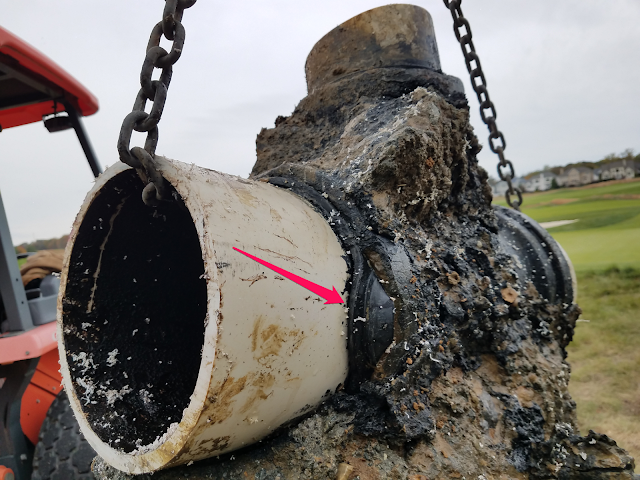Irrigation leaks are never any fun, and when the pipe size is 8", you can expect a big hole will be needed to make the repair. Such was the case a week ago, when suddenly, up from the ground came a significant amount of water.
In situations like this, digging carefully is mandatory. We not only don't want to rip the pipe out of the ground, but we also need to avoid damaging the myriad wires which run alongside the pipe.
Step two in this surgical procedure was cutting out the old tee. Virtually none of the irrigation pipe on the golf course is glued together. Instead it is pushed together using belled end pipe with gaskets. Therefore, it is primarily the weight of the soil which holds the pipe in place. However, where fittings such as tees and elbows are installed, concrete thrust blocks were poured to prevent the pipe from moving. As you can see below, the concrete thrust block came out with the tee.
Once we had the tee out, we could finally see exactly where the problem was. The ductile iron tee corroded to the point that its rubber gasket blew out. Similar to a car's tire separating from the rim, once the gasket's seal was broken, water was able to freely escape the pipe.
When repairing pipes we no longer have the room to push pipe into a new fitting. In a situation like this, some type of repair coupling is used. There are many different kinds, but on the recommendation of an experienced irrigation contractor, we chose a repair coupling which was new to us. One of the advantages to this model, is that there is only a single bolt to tighten on each end. This may not sound like a big deal, but inevitably, tightening bolts on the bottom of a pipe in a muddy hole, is less than ideal. One bolt, situated on top of the pipe is a big improvement.
Once the repair couplings were in place, we poured our own thrust blocks to prevent any possible pipe movement, and the couplings themselves are wrapped in plastic. This way, should the repair ever need to be dug up, we won't have to be chipping concrete off the couplings. The finished product may not look beautiful, but it is effective.
Again, these main line repairs are never a party. However, to look at the glass as half full, the pipe wasn't eight feet deep, the wires were looped around the existing fitting giving us plenty of room to work, and it took place in November, not July!













